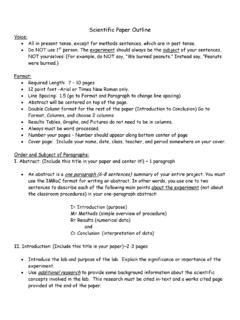Transcription of Red Mountain High School .. · EMERGENCY ACTION PLAN …
1 Red Mountain high School .. EMERGENCY ACTION PLAN FOR ATHLETICS PREPARED BY: Gerilyn Trulove-Mellor ATC Head athletic Trainer Updated August 7, 2006 RED MOUNT AI~ high School EMERGENCY ACTION PLAN FOR ATHLETICS Table of Contents I OVERVIEW OF THE EMERGENCY ACTION PLAN II II II I DEALING WITH SPORT EMERGENCIES AT RED Mountain high School I I Baseball/ Softball Complex I Gym Venues ,. I Football Field Venues II ' ' -I I athletic TRAINING ROOM POUCIES AND PROCEDURES I The Role of the athletic Trainers I athletic Trainer Priorities Training Room Hours I Training Room Rules: The Sixteen Commandments II Reporting Injuries II Taping & Treatments.
2 Services Available II Over the Counter Medications II Physician Referrals II Getting Hurt on the Field II other Injury Management II I Blue Cards II First Aid and CPR training for Coaches I Travel Kits Student athletic Trainers Injury Privacy and the Law Contacting Certified athletic Trainers I II BASIC INJURY MANAGEMENT FOR SPORT COACHES II Brain Injury-Concussions I Equipment Concerns II H~drating Athletes II Heat Related IDness II Treatment strategies for Heat Related Illness II I Lightning I I Cold Related Injuries I Wound Care - I Fractures I Sprains and strains I Seecial Considerations I Skin Disorders I Su~elements I II I BASIC TAPING TECHNIQUES FOR SPORT COACHES II I Ankles II I Foot Arch II il.
3 Groin I II . -Thumb I II Wrist II II I l A~pendix A : EMERGENCY Numbers I Appendix B: EMERGENCY Plan for Individual Teams I Appendix C: Concussion Management I A~pendix D: Heat Index Practice Guidelines I 31 I 7 I 71 91 11 1 13 13 13 14 14 1 15 1 15 I 15 15 15 16 16 16 16 16 16 17 17 17 18 19 21 21 22 23 241 25 26 27 28 2a 1 29 30 31 32 33 34 361 371 RED Mountain high School EMERGENCY ACTION PLAN FOR ATHLETICS OVERVIEW Introduction EMERGENCY situations may arise at anytime during athletic events. Expedient ACTION must be taken in order to provide the best posSible.
4 Care to the sport participant of EMERGENCY and/or life threatening conditions. The development and implementation of an EMERGENCY plan will help ensure that the best care will be provided. As emergencies may occur at anytime and during any activity, all School activities workers must be prepared. athletic organizations have a duty to develop an EMERGENCY plan that may be implemented immediately when necessary and to provide appropriate standards of EMERGENCY care to all sports participants. As athletic injuries may occur at any time and during any activity, the sports medicine team must be prepared.
5 This preparation involves formulation of an EMERGENCY plan, proper coverage of events, maintenance of appropriate EMERGENCY equipment and supplies, utilization of appropriate EMERGENCY medical personnel, and continuing education in the area of EMERGENCY medicine and planning. HopefuUy, through carefUl pre;>anicipation physical screenings, adequate medical coverage, safe practice and training techniques and other safety avenues, some potential emergencies may be averted. However, accidents and irijuries are inherent wilh sports participation, and proper preparation on the part of the sports medicine team sbou1d enable each ; EMERGENCY situation to be managed appropriately.
6 Components of the EMERGENCY Plan These are the basic components of every EMERGENCY ACTION plan for athletics: 1. EMERGENCY Personnel 2. EMERGENCY Communication 3. EMERGENCY Equipment 4. Roles Of Certified athletic Trainers, Student Trainers, Coaches, And Administrators 5. Venue Directions With map The Red Mountain high School EMERGENCY ACTION Plan also includes the following: athletic Training Room Policies and Procedures. Basic Injury Management for Coaches Basic Taping Techniques for Coaches EMERGENCY Plan Personnel With athletic practice and competition, the first responder to an EMERGENCY situation is typically a member of the sports medicine staff, most commonly a certified athletic trainer.
7 A team physician may not always . be present at every organized practice or competition, The type and. degree of sports medicine coverage for an athletic event may vary widely, based on such factors as the sport or activity, the setting, and the type of 1railring or competition. The first responder in some instances may be a coach or other institutional personnel, Certification in cardiopulmonary resuscitation (CPR), first aid, prevention of disease transmission, and EMERGENCY plan review is strongly recommended for al athletics personnel associated with practices, compe1ifions, skills instruction, and strength and conditioning.
8 The development of an EMERGENCY p1an cannot be complete without the formation of an EMERGENCY team. The EMERGENCY team may consist of a number of healthcare providers including physicians, EMERGENCY medical technicians, certified athletic trainers; student athletic trainers; coaches; parents; and, possibly, other bystanders. Roles of these individuals wi1hin the EMERGENCY team may vary depending on various factors such as the number of members of the team, the athletic venue itself, or the preference of the head athletic 1rainer.
9 There are four basic roles within the EMERGENCY team. The first and most important role is establishing safety of the scene and immediate care of the athlete. Acute care in an EMERGENCY situation should be provided by the most qualified individual on the scene. In most instances, this role will be assumed by the Certified athletic Trainer, although if the team physician is present he/she may be called in. The second role, EMS activation, may be necessary in situalions where EMERGENCY transportation is not already present at the sporting event This should be done as soon as the situation is deemed an EMERGENCY or a life-threatening event Tune is the most.
10 Critical fcl;tor under EMERGENCY conditions. Activating the EMS system may be done by anyone on the team. However, the person chosen for this duty should be someone who is calm under pressure and who eotmlllnicates well over the ~hone. This person should also be faniliar with the location and address of the sporting event Typically, the School adninislrator is the best choice to fulfil this role. The 1hid role. equipment re1rieval may be done by anyone on the EMERGENCY team who is famifiar with the types and location of the specific equipment needed.



















